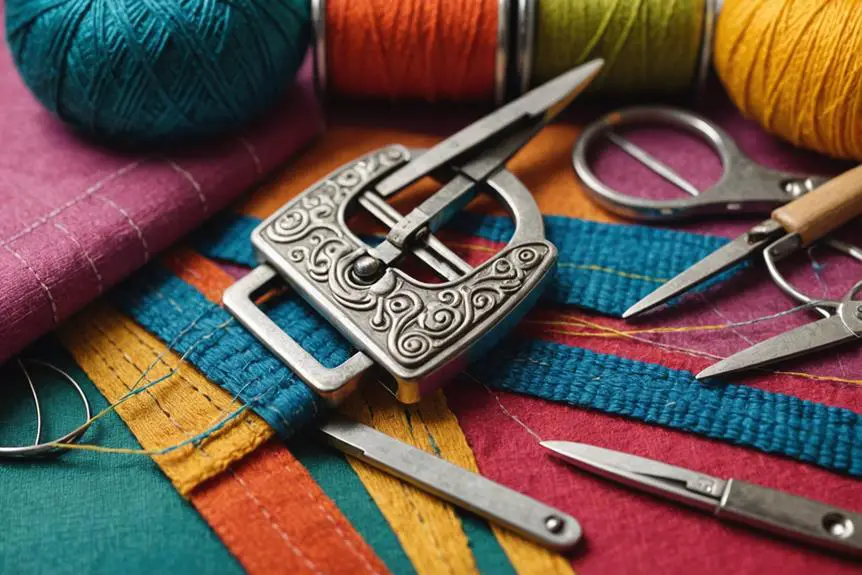When you notice fraying on your belt buckles or straps, it can be tempting to just toss them aside, but you don't have to. Start by evaluating the damage to determine the best way to fix it. You'll need a few simple materials, and with some careful preparation, you can restore your belt to its former condition. Once you've got everything ready, applying adhesive for durability becomes essential. Curious about the best techniques and preventive measures to keep your belts looking new?
Assessing Fraying Damage
When you notice fraying on your belt buckle or strap, it's vital to evaluate the damage right away. You don't want to risk your favorite belt becoming a fashion faux pas! Start by inspecting the edges of the strap or buckle. Are there loose threads? Is there significant wear? If it looks like it's been through a battle, it's time to take a closer look. Regular checks for frayed edges or loose attachments can help prevent further issues, just like maintaining your common hoodie drawstring issues.
Make sure you determine whether the fraying is just a minor issue or if it's compromised the belt's integrity. If it's superficial, a simple trim might do the trick. But if the fraying is serious, you'll need a more robust repair approach. Measuring the length of the frayed area is also important. You want to know how much you need to cut or treat to get your belt back in action.
Don't forget to think about the material type of your belt, too! Is it fabric or leather? Knowing this will help you choose the best repair method. Plus, keep an eye out for any fraying patterns. Are they repeating? If so, it might be time to reflect on a different belt design or buckle to prevent future damage. After all, you want to strut your stuff with confidence, not worry about a frayed belt ruining your vibe. So, roll up your sleeves and get evaluating! Your trusty belt deserves it!
Required Repair Materials
Alright, let's talk about what you'll need to fix those fraying belt buckles or straps! You'll want a fraying fabric belt that matches your material, some trusty superglue, and a sharp blade for those precise cuts. Plus, don't forget clamps or a vice to hold everything steady while the glue does its magic—because who wants a wobbly repair, right?
Essential Repair Items
To effectively repair fraying belt buckles or straps, gather a few essential items that will make the process smooth and efficient. First up, you'll need a fraying fabric belt that's compatible with any material you're working with. This guarantees your repair techniques fit perfectly, so you don't end up with a hot mess!
Next, grab a regular type of superglue. It's easy to use and creates a strong bond for those frayed areas. You'll also want a sharp blade, like a Stanley knife, to trim the frayed ends neatly. Trust me, precision is key here—nobody wants a jagged edge messing up their style!
Don't forget clamps or a vice! These handy tools will keep your belt secure while you work, preventing any slips or wiggles. And remember, having a steady hand is essential. It's all about getting that neat trim ready for a durable repair.
Tools for Effective Repairs
Having the right tools on hand can make all the difference in repairing a fraying belt strap. First up, you'll need a fraying fabric belt and a sharp blade, like a Stanley knife. Trust me, a steady hand is key here! Next, grab some superglue—regular type works best for easy application—and clamps or a vice to hold everything in place.
When you're ready to plunge into those repair techniques, first trim the frayed end of the belt. This neatens things up and gives you a clean surface to work with. Once you've got that done, use the superglue to saturate the last 3-4 rows of fabric. Let it soak in on both sides to strengthen those fabric types.
Oh, and don't forget to secure the belt while cutting! It keeps everything steady for best results. Use multiple strokes with your sharp blade for tough materials, checking the trimmed edge afterward. If it feels a bit rough, roll it to soften. With the right adhesive options and tools, you'll have that belt looking good as new in no time! Ready to get started?
Preparing the Belt for Repair
Preparing the belt for repair starts with a thorough inspection of the fraying end to assess the damage. You'll want to check how much it's frayed and if trimming is necessary for a neat appearance. After all, you don't want to walk around with a belt that looks like it survived a battle! In some cases, a quick fix using everyday items for repairs can be effective while you plan for a more permanent solution.
Lay the belt flat on a clean work surface. This makes it super easy to see what you're working with and guarantees you don't miss any details. Next, gather all your materials—think superglue, a sharp blade, clamps or a vice. Having everything within reach makes the repair process smoother.
Now, let's talk about trimming. Use that sharp blade to cut the frayed end into a clean edge. This isn't just for looks; it'll help with the next steps of applying adhesive and securing your belt for durability. And remember, different belt types and fabric compatibility play a role here—some materials may be trickier than others, so keep that in mind when you're prepping.
Before diving into the repair, check that your working area is free from debris. Trust me, you don't want any glue mishaps that could turn into a sticky situation! Plus, regular repairs can save your favorite belts from the trash can, extending their life. So, are you ready to get started on making that belt look brand new? Let's do this!
Applying Adhesive for Durability
Now that you've got your belt prepped, it's time to immerse yourself in applying adhesive for durability. This step's essential for keeping those frayed edges in check! To start, you'll want to grab a thin, runny superglue. Why? Because it soaks right into the fabric fibers, giving you a solid hold. Additionally, it's wise to reflect on reinforcing the area with a patch for increased durability, similar to the techniques for repairing torn pockets.
Here's how to do it right:
- Choose the right superglue type: Look for one that's compatible with your fabric. Not all superglue types are created equal, and using the wrong one can lead to more trouble!
- Apply with care: Focus on the last 3-4 rows of frayed fabric. Make sure you saturate both sides. You want to give those fibers a fighting chance against future fraying!
- Clean workspace: Before you start, verify your area is free from debris. This way, the glue doesn't stick to anything it shouldn't, and you keep your repair process straightforward.
After applying the glue, let it cure for several hours. Patience is key here—this bond needs to be strong to withstand the daily wear and tear. Once it's set, trim away any excess frayed ends and roll the newly cut edge to soften it up. This little trick not only prevents more fraying but also makes your belt look sharp! So, are you ready to give your belt a fresh lease on life?
Finalizing the Repair Process
To wrap up your belt repair, it's crucial to guarantee everything's set before you put it back into action. First off, make sure that superglue you applied has fully cured. You don't want to rush this part; give it several hours. Trust me, you'll thank yourself later when that bond holds strong!
Now, to finalize the repair, grab some clamps or a straightedge. Securing the belt keeps it steady while you trim the frayed end, helping you achieve a clean cut. Use a sharp blade, like a Stanley knife, and make multiple strokes. Just remember, safety first! Check that trimmed edge for durability and smoothness; it's worth the effort.
Next, roll the cut edge gently. This little trick softens the edge and helps prevent further fraying, giving your belt those finishing touches it deserves. Nobody wants a belt that looks like it got into a fight with a lawnmower, right?
Preventive Maintenance Tips
After you've finalized your repair, it's time to think about how to keep your belts in top shape. Preventive care is key! By following a simple maintenance schedule, you can guarantee your belts last longer and look great. Here are some longevity strategies you should adopt:
- Regular Inspections: Check the ends of your belts and straps for any signs of fraying. Catching these issues early can prevent them from getting worse. It's like checking your tire pressure—better safe than sorry, right?
- Seal the Deal: If you notice any fraying or cut ends, apply a sealant like superglue. This little step can save your belts from an untimely demise. Think of it as giving your belt a superhero cape!
- Smart Storage: When you're not wearing your belts, store them properly. Hanging or rolling them helps avoid unnecessary stress on the material. A happy belt is a long-lasting belt, after all!
And don't forget to choose belts with protective end tips or reinforced edges to minimize fraying from everyday wear. A little foresight goes a long way! By incorporating these preventive maintenance tips into your routine, you'll keep your belts looking sharp, saving you time and money in the long run. So, why not start today? Your belts will thank you!
Frequently Asked Questions
How to Fix a Fraying Belt?
To fix a fraying belt, you can use belt repair techniques like trimming frayed edges and applying superglue. For fraying prevention tips, consider fabric sealing methods to enhance durability and stop future damage.
How Do You Fix Belt Loops on Dress Pants?
When your belt loops need a little TLC, try these sewing techniques for a belt loop repair. You can reinforce the fabric with thread to guarantee durability and keep your dress pants looking sharp.
How to Fix Peeling Faux Leather Belt?
To address peeling on your faux leather belt, use peeling repair techniques like adhesive and color-matching compounds. Follow belt care tips, storing it properly to enhance faux leather restoration and prevent future damage.
How Do You Fix the End of a Belt?
Did you know that nearly 30% of belts show signs of wear within a year? To fix the end of a belt, use fabric adhesives, sewing techniques, and follow essential belt maintenance tips for durability.





Hello there I am so grateful I found your webpage, I really found
you by accident, while I was researching on Askjeeve for something else, Anyways I am
here now and would just like to say thanks
for a tremendous post and a all round exciting
blog (I also love the theme/design), I don’t have time to go through it all at the moment
but I have book-marked it and also added your RSS feeds, so when I have time I will be back to
read a lot more, Please do keep up the fantastic job.
webpage
You can certainly see your expertise in the work you write.
The arena hopes for even more passionate writers such as
you who aren’t afraid to mention how they believe.
All the time go after your heart.
casino en ligne
This website was… how do you say it? Relevant!! Finally
I have found something which helped me. Thanks a lot!
casino en ligne
Pretty! This was a really wonderful post. Thank you for providing this info.
casino en ligne
Appreciate the recommendation. Will try it out.
casino en ligne
I think what you wrote was very reasonable. But, what about this?
suppose you wrote a catchier post title? I mean, I don’t wish to tell you how to run your website, however what if you added
a post title that makes people want more? I mean How to Fix Fraying Belt Buckles or Straps on Your Clothes – VCG is kinda plain. You should look at Yahoo’s home page and note how they create post headlines to
grab people to open the links. You might add a related video or a related
pic or two to get people excited about what you’ve
written. Just my opinion, it could make your posts a little livelier.
casino en ligne
Howdy this is kinda of off topic but I was wanting to know
if blogs use WYSIWYG editors or if you have to
manually code with HTML. I’m starting a blog soon but have no coding
know-how so I wanted to get guidance from someone with experience.
Any help would be greatly appreciated!
casino en ligne
Everything is very open with a precise clarification of the challenges.
It was definitely informative. Your site is useful. Many thanks for sharing!
casino en ligne
Hi there to every single one, it’s actually a nice for me
to go to see this site, it contains important Information.
casino en ligne
Thanks for another excellent post. The place else could anyone get that kind of information in such a perfect manner of writing?
I’ve a presentation next week, and I am on the look for such
information.
casino en ligne